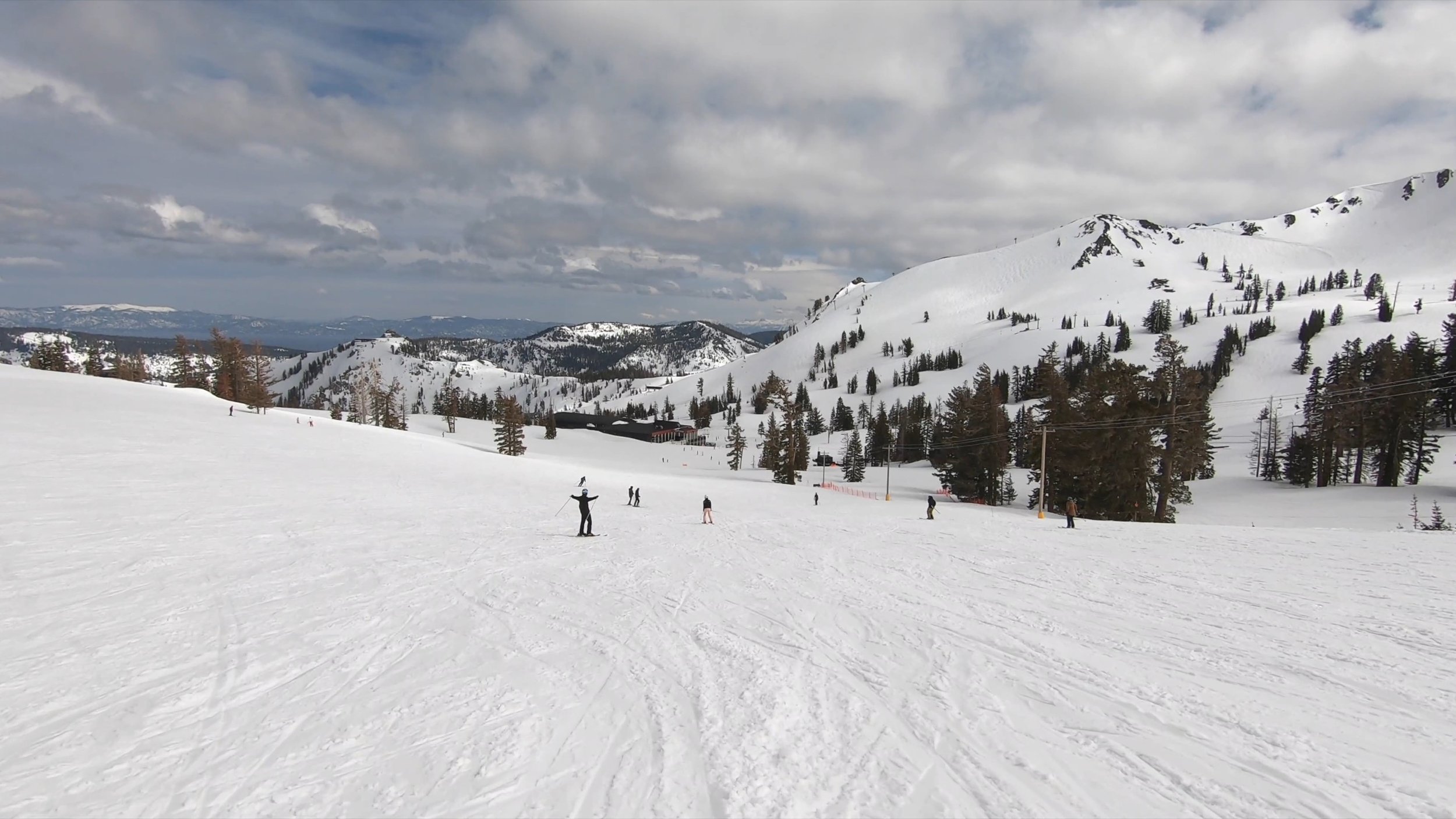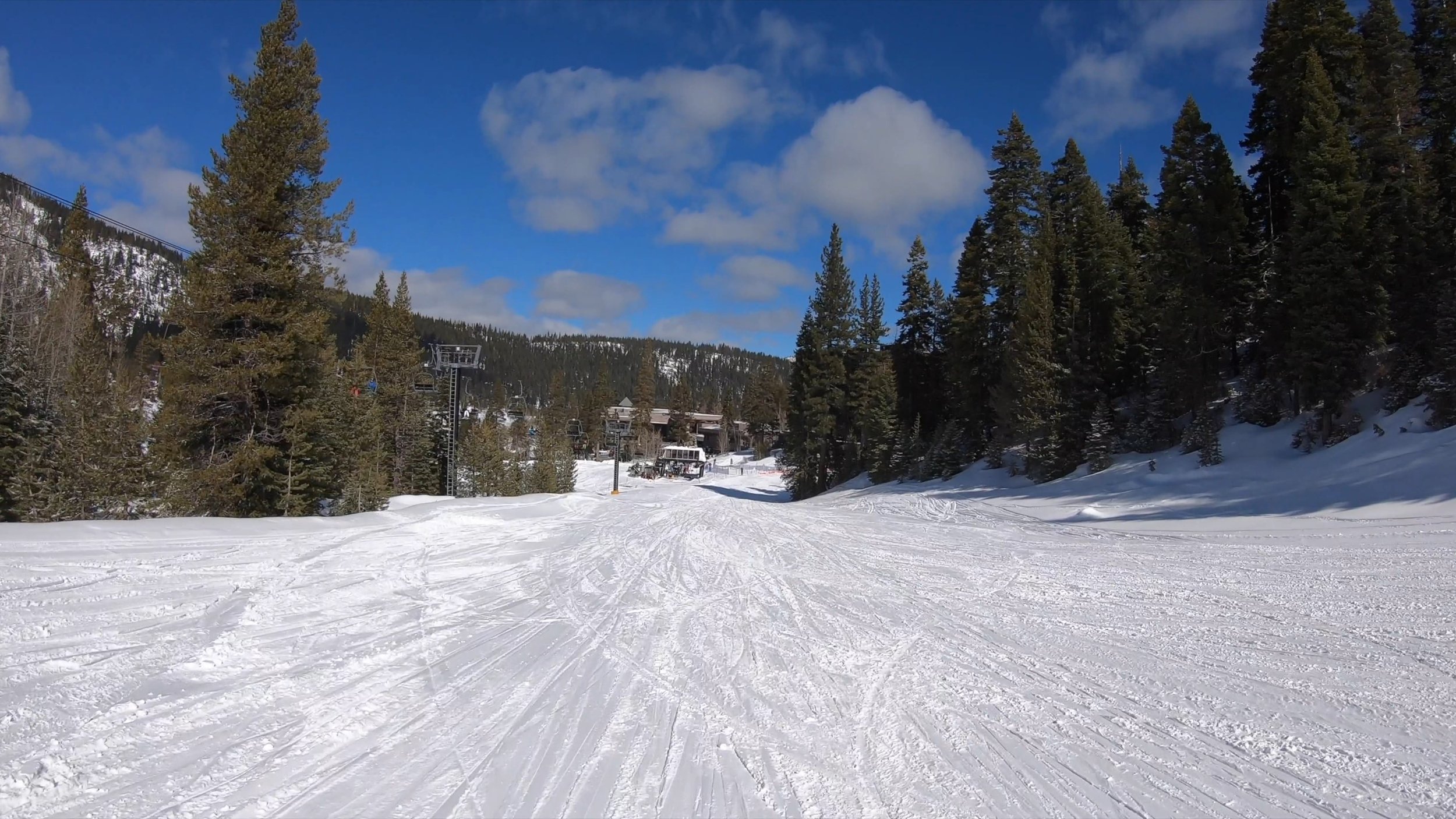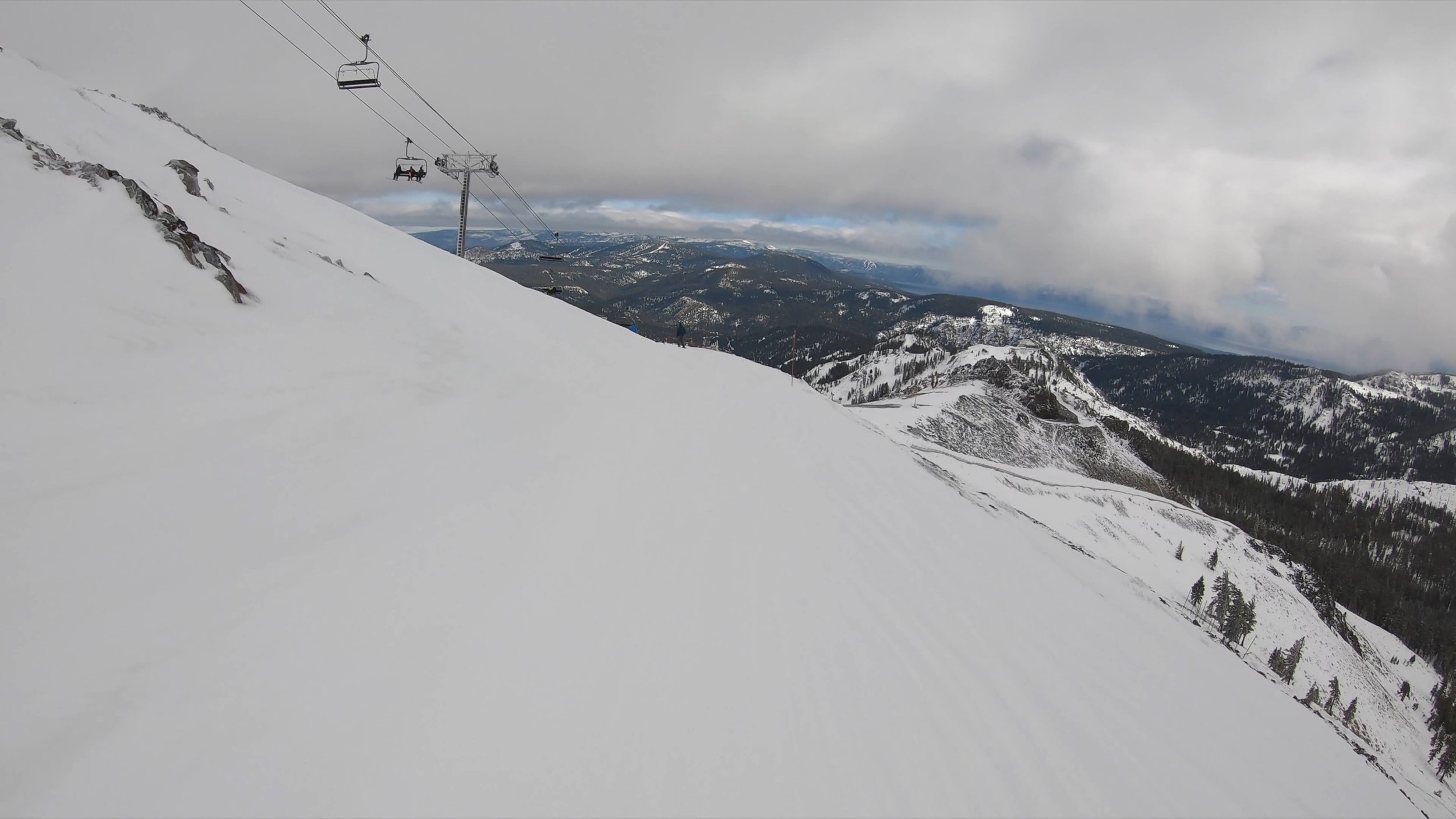Palisades Tahoe Terrain Zones Ranked: Forgettable to Must-Hit
Palisades Tahoe is one of the most iconic ski resorts in North America, with an expansive footprint, legendary steeps, and distinctive, character-filled slopes. But with so much terrain to cover across such a unique setup, surely some of Palisades Tahoe’s slopes must be worth hitting over others?
What if you only have a limited amount of time at the resort, and you need to prioritize where to spend your time?
Not to worry! In this piece, we’ll rank the different zones of terrain at Palisades Tahoe based on the overall experience, and we’ll go through the pros and cons of each one.
And to keep this article to a reasonable length, we’ll just stick to the Palisades side, formerly known as Squaw Valley, for this ranking. We’ll leave the Alpine Meadows side, which is a 20-minute Base-to-Base Gondola ride away, for another article.
#13: Mountain Run
Coming in at the bottom of this list is an area that most guests will unfortunately become very familiar with—and that’s the Mountain Run pod.
This area is really only two intermediate trails: Mountain Run and Sunnyside, but it’s the only way out of the upper mountain without downloading the funitel or tram. Accordingly, these trails get incredibly congested and not fun.
If you’re not careful, you can easily collide with other people on these trails. This is the only place at Palisades Tahoe that’s so notorious that the resort itself recommends avoiding it, with signs in the funitel cabins warning of the area’s issues.
Not only is the Mountain Run area the least fun at Palisades Tahoe, but it might be the most overcrowded trail area at any major North American ski resort.
#12: Silverado
Coming in next on this list is the Silverado zone, and if you haven’t visited Palisades Tahoe several times, you may not even know this area exists in the first place.
Silverado actually has a lot going for it on paper, with all sorts of cool terrain features, ranging from bowls, to glades, to rock-lined trails. The area boasts a particularly intense expert footprint, including cliff drops of up to 100 feet in some places. Silverado is also in a somewhat hidden location, so it’s less tracked out than some of the resort’s other expert-oriented areas.
But Silverado has one cataclysmic drawback: it’s basically never open. Palisades Tahoe only opens this lower-elevation terrain a handful of days each winter, and if it’s been a bad snow year, the resort may not even open the lift at all. And even if it is a good snow year, Silverado is often last in line for avalanche mitigation and lift access work, which means that openings are still hard to predict. Silverado is a ton of fun for experts when it’s open, but we can’t really put an area that’s so reliably closed any higher on this list.
#11: Solitude
The first intermediate-oriented area on this list that’s actually enjoyable, Solitude offers sheltered skiing and riding on the resort’s backside. Solitude’s runs are well-groomed, and the area features favorable exposure and decent tree skiing, especially for those who aren’t ready for more intense glades elsewhere at the resort. In addition, Solitude doesn’t typically see the same crowds as other resort areas.
But Solitude’s runs aren’t that distinctive, with many of them feeling interchangeable with normal resorts you wouldn’t fly to ski or ride at. In addition, Solitude’s slow triple chair makes it a slog to lap over and over again. Ultimately, there are just more unique and enjoyable places to spend time at the resort.
#10: High Camp
The only truly beginner-oriented zone at Palisades Tahoe that’s not a first-timer’s bunny hill, High Camp looks really good on paper. This area is home to some of the only upper-mountain learning terrain in North America, with awesome lake views and a wide-open footprint.
But it turns out there’s a reason why other ski resorts don’t have their beginner areas high up in the mountains, and High Camp faces a range of logistical issues that make it really impractical as a place to learn how to ski. First off, the wide-open footprint makes for profound wind exposure, making for cold, windswept slopes that are more likely to make beginners never want to go skiing again than appreciate the lake views. Wind holds are common—and when the High Camp lifts are closed, beginner options are incredibly slim. Additionally, there’s no beginner way to ski down to the bottom of the resort, meaning that most guests spending time in this area will need to download the tram or Funitel to leave the resort at the end of the day.
High Camp seems really cool at first—and if you get there on a warm, low-wind day, it’s a great place to learn. But most of the time, it’s just way too variable to make sense as a practical beginner area.
#9: Broken Arrow
Next up we have Broken Arrow, which, for the purposes of this piece, we’re considering as the terrain directly served by the Broken Arrow lift, as well as the runs directly under the Funitel.
At a first glance, this area is home to some of the coolest terrain in Tahoe. These advanced and expert trails are bounded by stunning rock formations that make it feel like you’re skiing or riding through a national park. Broken Arrow isn’t home to the most extreme terrain at the resort, but the trails can include some sections of cliff drops and straightlining depending on conditions. And since most of these runs lead down to the base, you get to skip a large chunk of the horrendous Mountain Run experience.
But like Silverado, Broken Arrow is very rarely open. The rocky, southeast-facing nature of this terrain means it takes a ton of time to fill in, and during bad seasons, it can be months before the resort drops the rope. The Broken Arrow lift almost never runs, and when it’s not operating, a sizable minority of this terrain is either hike-to only, or closed. This terrain zone has some really cool runs, but like with Silverado, you shouldn’t plan a trip to Palisades Tahoe specifically to ski or ride here.
#8: Gold Coast / Emigrant
Next up we have Emigrant and Gold Coast, two lifts that run in slightly different places but largely serve the same terrain pod. This area is chiefly home to intermediate terrain, with a couple of expert trails thrown in near the top of Emigrant. Gold Coast also hosts most of Palisades Tahoe’s terrain park features, which in select seasons include a quarter or halfpipe build.
But this area hosts Palisades Tahoe’s most prominent high-alpine intermediate terrain, which makes the trails here, and specifically those off the Gold Coast six-pack, really crowded. The top of Emigrant features this area’s most interesting terrain, but the Emigrant lift is a slow triple chair that’s subject to frequent wind holds. Speaking of wind, it really tends to scour the slopes here, resulting in variable, icy conditions.
Gold Coast and Emigrant have some pretty excellent views, but after a lap or two here, you’ll probably want to make your way somewhere else.
#7: Resort Chair
Next up, we have what’s in our view the first legitimately standout below-treeline terrain at Palisades Tahoe. The Resort Chair, formerly known as Squaw Creek before the resort rebranded in 2021, is home to modest crowds and some of the resort’s only good intermediate cruisers. In addition, this area includes some gnarly expert woods terrain, and stays much more resilient to weather holds than higher elevation areas.
But with the exception of the base-to-base gondola connecting the Palisades and Alpine mountain sides, the Resort Chair is the longest lift ride at Palisades Tahoe, taking nine minutes on a slow, fixed-grip triple chair to get from bottom to top. In addition, the area’s more sheltered terrain may help with wind holds, but the lower elevation hurts snow preservation somewhat. The Resort Chair services some pretty good terrain, but other areas have faster lifts, more unique slopes, and a larger quantity of trails.
#6: Shirley Lake
Next up we have Shirley Lake, and if you’re an intermediate, this is the place to be. This area’s high-elevation, north-facing footprint allows for better-than-average natural snow preservation, and the shorter trails make it a good progression area after hitting Palisades Tahoe’s beginner terrain.
But these strengths are no secret, and just about everyone ends up at Shirley Lake on peak weekends and holidays. Combined with certain trails from other terrain zones filtering into this pod, and there being no easy way to get back to the base without riding the Shirley Lake lift back up, this area turns into a huge chokepoint. The heavy traffic also counteracts the favorable terrain aspects, and slopes often get skied off quickly. And even though it’s pretty high up, Shirley Lake doesn’t actually stand out all that much in terms of its views.
Shirley Lake is a great area if you’ve never skied anything but groomers, but if you’re more experienced than that, there are better places to spend your time.
#5: Headwall
Moving a bit further down the mountain, Headwall is home to a large chunk of Palisades Tahoe’s mid-mountain steeps. This area hosts incredibly trying expert terrain, and while generally not as extreme technicality-wise as the craziest places on the mountain, Headwall features long, endurance-busting mogul runs—and some really cool views.
However, Headwall is an incredibly exposed terrain zone. The high-speed six-pack is often subject to wind holds, and when it isn’t, the lift sees substantial lines. Headwall is certainly home to steeps that Palisades Tahoe is known for, but it’s less reliable and less iconic than other expert-oriented terrain zones.
#4: Siberia
Immediately to skiers’ left of Headwall, the Siberia area doesn’t have quite the same vert as its eastern neighbor, but it has a few things going for it that make it just a slightly better place to spend time.
The high-alpine Siberia offers some of Palisades Tahoe’s best bowls, with options for intermediate to advanced visitors served by a easily-lappable high-speed six-pack. Siberia is certainly exposed to some degree, making it cold and windy, but it’s not the worst offender at Palisades Tahoe, and it’s more reliable than all the other advanced and expert terrain areas we’ve covered so far.
And while its directly-lift-served slopes aren’t as tough as those in other resort terrain zones, Siberia offers the most direct access to the Palisades zone, an iconic hike-to area with chutes ranging from expert to truly extreme. The Palisades are home to mandatory cliff drops of as long as 50 feet when conditions allow, and the toughest pitches are among the most dangerous in all of North America.
#3: Red Dog
If you’ve been to Palisades Tahoe before, you’ll know that Red Dog is essentially the antidote to the resort’s biggest weaknesses. Unlike the highly exposed slopes elsewhere, the out-of-base Red Dog zone is quite sheltered, allowing the area to stay reliably open, even through storms. In addition, this lower-mountain terrain zone holds some really gnarly expert lines, including cliffs, chutes, and some of the thickest glades on the mountain.
But if you haven’t visited Red Dog since this past season, you might be shocked to see it this high on the list—after all, the Red Dog was bogged down by a dated triple lift, with a slow speed, long ride time, and frankly scary heights at times that made for a less-than-desirable ride. However, the Red Dog area was recently upgraded with a brand-new high-speed six-pack, which has cut down the ride time by over 60%, adjusted the alignment to go over less crazy heights, and just generally made for a much more enjoyable experience in this area.
Red Dog’s expert zones are subject to somewhat variable openings due to their lower elevation, but otherwise, it’s the place to be when everything else is closed.
#2: Granite Chief
Granite Chief, which is the furthest removed area from Palisades Tahoe’s base, services the resort’s highest elevation terrain. The area is unique in that it both offers some of the best wind protection and snow preservation at the resort. If you can name a flavor of expert terrain, you’ll find it at Granite Chief, with the area boasting tree-defined chutes, glades, cliffs, rocks, and hike-to couloirs. And while Granite Chief is served by a slow triple chair, the tree-sheltered terrain means the lift ride isn’t too painful.
Granite Chief is dependent on other backside lifts for both access and egress, so upper mountain wind can cause closures. In addition, Granite Chief is an advanced and expert-only zone—there are no easy or intermediate ways down. But this upper-elevation area ironically offers some of the best tree-defined terrain in Tahoe, and it’s worth checking out for any expert who makes a trip here.
In fact, we’d prioritize a visit to Granite Chief over any other section of the resort—except one.
#1: KT-22
If you’ve done even a small amount of research on Palisades Tahoe before, you’ll know there’s no other terrain zone that could end up on the top of this list besides KT-22. This area has truly unparalleled expert terrain, including some of the most iconic features at the resort, such as the Fingers and Eagle’s Nest.
But even if you don’t have an appetite for mandatory cliffs or straightlining, KT-22 is home to tons of varied expert terrain, including chutes, bowls, and glades, and no two trails feel the same. And since KT-22 is directly accessible from the base, you don’t even have to work to find it.
KT-22 doesn’t serve any green or blue trails, and both sees crazy lift lines and gets skied out quickly. And we have to note that the new Base-to-Base Gondola now runs directly over the heart of this terrain, creating a controversial new aspect to this area’s legendary facade. But no trip to Palisades Tahoe is complete without a trip up KT-22.
Final Thoughts
So that’s our ranking of the terrain zones on the Palisades side of Palisades Tahoe. The resort has a storied history and some really iconic terrain, but certain parts of the mountain are way better than others. The areas that land at the top of this list embody the resort’s greatest strengths, including world-class steeps, diverse terrain, and incredible views, while those near the bottom of this list embody some of the resort’s biggest weaknesses, including crowd congestion, variable terrain openings, and significant wind exposure.
If there’s one thing to take away from this list, it’s this: Palisades Tahoe, at least on the Palisades side, is a chiefly advanced and expert-oriented mountain. Every zone in the top 5 on this list mainly services black and double-black trails, and the areas that cater to lower abilities face circumstances that make for less enjoyable experiences than other comparable destinations. Thankfully, intermediates can hop on the Base-to-Base Gondola and head over to the Alpine side for standout terrain for that ability level over there.
For more information on Palisades Tahoe, check out our comprehensive mountain review. If you want to see how Palisades Tahoe compares to other similar mountains, check out our Lake Tahoe, California, and West Coast ski resort rankings.













